
The Victorian Artists Society, which can trace its establishment to 1856 in Melbourne, promotes artistic education, art classes and gallery hire exhibition in Australia. It was formed in March 1888 when the Victorian Academy of Arts and the Australian Artists' Association amalgamated.

The City of Banyule is a local government area in Victoria, Australia in the north-eastern suburbs of Melbourne. It was created under the Local Government Act 1989 and established in 1994 as an amalgamation of former councils. It has an area of 63 square kilometres (24.3 sq mi) and lies between 7 and 21 km from central Melbourne. In 1994 it had a population of 116,000. In June 2018 Banyule had a population of 130,237. The Yarra River runs along the City's southern border while its western border is defined by Darebin Creek.

Heidelberg is a suburb of Melbourne, Victoria, Australia, 11 kilometres (7 mi) northeast of Melbourne's central business district, located within the City of Banyule local government area. Heidelberg recorded a population of 7,360 at the 2021 census.
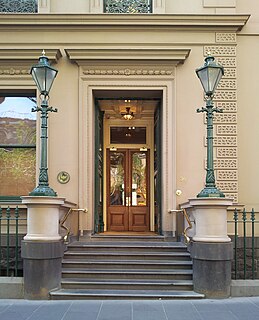
The Melbourne Club is a private social club established in 1838 and located at 36 Collins Street, Melbourne.

Eaglemont is an established suburb of Melbourne, Victoria, Australia, 10 km north-east of Melbourne's Central Business District, located within the City of Banyule local government area. Eaglemont recorded a population of 3,960 at the 2021 census.
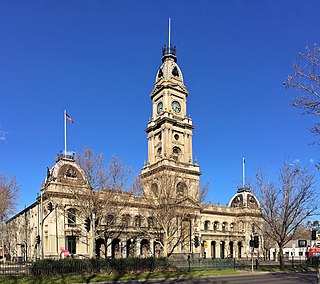
Collingwood Town Hall is a civic building located on Hoddle Street in Abbotsford, a suburb of Melbourne, Australia.
Harry Norris was an Australian architect, one of the more prolific and successful in Melbourne in the interwar period, best known for his 1930s Art Deco commercial work in the Melbourne CBD.
Yarra Plenty Regional Library (YPRL) provides a public library service to the local government municipalities of the City of Banyule, Shire of Nillumbik and City of Whittlesea in the northeast of Melbourne Australia and located on the lands of the Woiworung. It is an independent legal entity with an executive management team which is responsible for day-to-day operations of the organisation. It is managed by the Yarra Plenty Regional Library Board made of two representatives (councillors) of the three municipalities that constitute the service. Its role is to set the policy and direction for the regional library service. The library service covers an area of 988.4 km² including metropolitan, urban fringe and rural populations. The organisation is administered from its Library Support Services (LSS) located at Daniher Drive, Sth Morang.YPRL also provides computer services to Murrindindi Library Service, including full access to the library's database.
Australian non-residential architectural styles are a set of Australian architectural styles that apply to buildings used for purposes other than residence and have been around only since the first colonial government buildings of early European settlement of Australia in 1788.
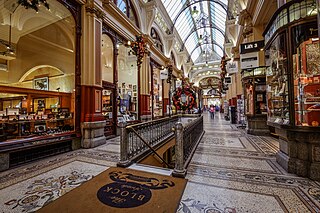
The Block Arcade is an historic shopping arcade in the central business district of Melbourne, Victoria, Australia. Constructed between 1891 and 1893, it is considered one of the late Victorian era's finest shopping arcades and ranks among Melbourne's most popular tourist attractions.

Ivanhoe is a suburb of Melbourne, Victoria, Australia, 9 kilometres (5.6 mi) north-east of Melbourne's Central Business District, located within the City of Banyule local government area. Ivanhoe recorded a population of 13,374 at the 2021 census.

Daryl Sanders Jackson AO is an Australian architect and the owner of an international architecture firm, Jackson Architecture. Jackson also became the associate professor of the University of Melbourne and Deakin University.

Harold Desbrowe-Annear was an influential Australian architect who was at the forefront of the development of the Arts and Crafts movement in the country. During the 1890s he was an instructor in architecture at the Working Men's College where he founded the T-Square in 1900. The club acted as a meeting point for Melbourne's architects, artists and craft workers and helped to develop a strong Arts and Crafts culture in the city. Desbrowe-Annear was also a supporter of the Victorian Arts and Crafts Society, founded in 1908.
The Margaret Lyttle Memorial School Junior Campus is the junior campus of Preshil. It was designed by Kevin Borland. The buildings that Kevin Borland designed at the Preshil School are experimental in design and uses triangular and hexagonal geometries together with diagonals in both plan and section. This creates a variety of internal and external spaces, irregular forms and buildings that strongly deviates from the conventional school buildings of that time. The precise forme of each building and its detailing is counteracted by the use of raw timber posts and beams.

The architecture of Melbourne, the capital of the state of Victoria and second most populous city in Australia, is characterised by a wide variety of styles dating from the early years of European settlement to the present day. The city is particularly noted for its mix of Victorian architecture and modern buildings, with 52 skyscrapers in the city centre, the most of any city in the Southern Hemisphere.
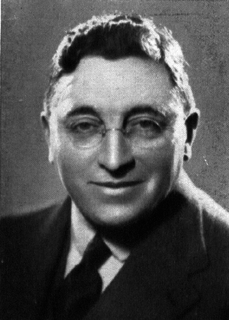
Joseph Plottel was a British born architect who was active in Melbourne, Australia between 1911 and World War II, working in a range of revival styles, as well as Art Deco in the 1930s. He is best known for the St Kilda Synagogue (1927) and the Footscray Town Hall (1936).

Berg and Alexandra was an Australian architecture firm from 1962 to 1996, based in Chelsea House, on Flemington Road in North Melbourne. The firm was formed by a partnership between two Melbourne architects Raymond Berg, born in 1913 in South Melbourne, and Douglas Alexandra, born in 1922 in Shepparton, Victoria. Berg retired in 1983 and died five years later, with Alexandra retiring in 1996 and selling the practice to Hudson and Wardrop. Berg and Alexandra were among the first post-war Australian architects to produce modernist works. They were heralded for their simple, stripped back designs that broke away from ‘the old familiar features’ of Australian Architecture.
Oakden, Addison and Kemp was an Australian architectural firm in Melbourne, Victoria. While it was short lived, existing from only 1887 to 1892, they designed a number of outstanding projects, and all three members designed many more notable projects in earlier and later partnerships.
Heidelberg Historical Society is a museum and research organisation devoted to the local and community history of Heidelberg and surrounding areas in the north-eastern suburbs of Melbourne, Victoria, Australia.
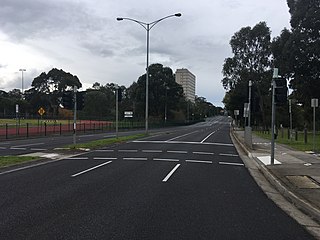
Heidelberg Road is a major arterial road through the north-eastern suburbs of Melbourne. It was the first road in Victoria outside the township of Melbourne. Heidelberg Road was the main route for people travelling to Heidelberg, from the mid to late 1800s.















